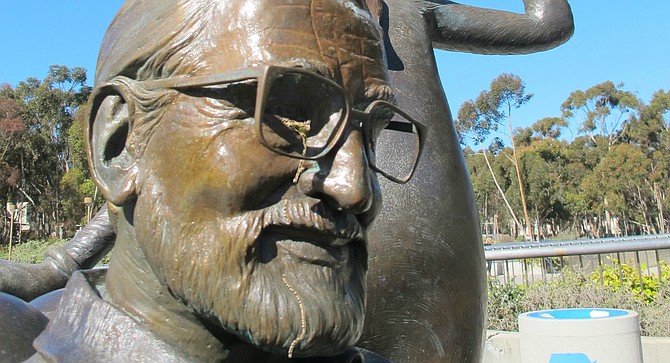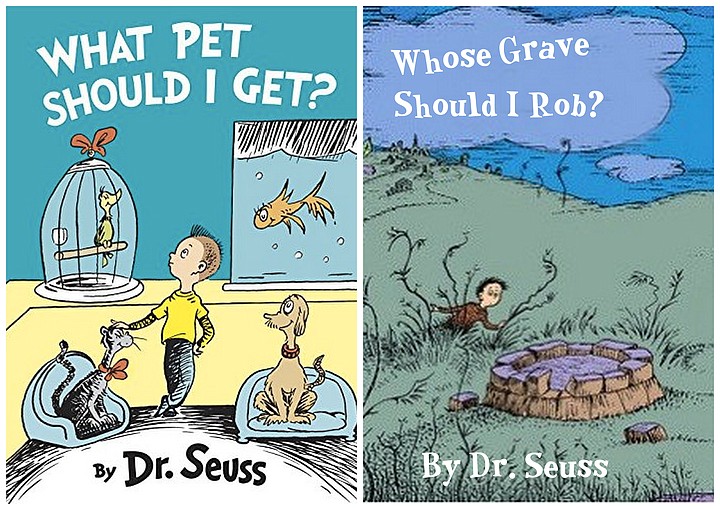 Facebook
Facebook
 X
X
 Instagram
Instagram
 TikTok
TikTok
 Youtube
Youtube

On July 28, Random House published What Pet Should I Get?, a parable about the paralyzing effects of endless choice in a wealthy consumer society written by beloved children's author Theodore Geisel, aka Dr. Seuss. Geisel, who died in La Jolla back in 1991, wrote and illustrated the story sometime around 1960, but never attempted to publish it during his lifetime. Jeffrey Craven, who manages the Seuss estate, is quick to stress that there could be any number of reasons for that, many of them having nothing at all to do with the author's wishes.

"Maybe he misplaced the manuscript. Or maybe he had an imaginary friend who had an imaginary dog, and that imaginary dog died, and he was so sad about it that he couldn't bear to publish this story during his own lifetime. Or maybe he thought The Grinch Who Stole Christmas was a more biting, yet hopeful critique of rampant American consumerism, and didn't want to overdo things. At any rate, I think recent events have made it clear that the good Doctor is very pleased with both the publication of What Pet Should I Get? and the huge financial success it represents." (The book has become an instant bestseller, replacing Harper Lee's Go Set a Watchman at the top of the sales lists.)
The recent event Craven refers to is the extraordinary — some would say miraculous — effluence of liquid gold from the right eye of the Theodore Geisel statue located on the UCSD Campus. Witnesses report that the "weeping" began shortly after midnight on publication day.
"Me and my friends were doing a post-party pic with the Cat in the Hat [standing behind the Seuss statue]," explains UCSD Sophomore Courtney Poser. "But the girl taking the shot — I think her name was Heather something? — said the flash kept reflecting off the old guy statue's face. We checked it out, and oh my god. I know this guy in the geology department, and I promised to do a selfie with him if he would analyze the stuff coming out of the statue's eye. Totally gold."
The student's findings have since been verified by the UCSD Dept. of Alchemy, which is refusing further comment until its own investigation has been completed.
Critics have compared the Weeping Geisel to the statues of the Virgin Mary or Jesus that have reportedly wept water or blood, and warned that the tears might be a sign of sadness instead of joy. "Nonsense," says Craven. "Jesus and Mary weep for the sins of the world — the blood and water signify atonement and cleansing. Ol' Ted weeps solid gold, signifying cash money, baby."


On July 28, Random House published What Pet Should I Get?, a parable about the paralyzing effects of endless choice in a wealthy consumer society written by beloved children's author Theodore Geisel, aka Dr. Seuss. Geisel, who died in La Jolla back in 1991, wrote and illustrated the story sometime around 1960, but never attempted to publish it during his lifetime. Jeffrey Craven, who manages the Seuss estate, is quick to stress that there could be any number of reasons for that, many of them having nothing at all to do with the author's wishes.

"Maybe he misplaced the manuscript. Or maybe he had an imaginary friend who had an imaginary dog, and that imaginary dog died, and he was so sad about it that he couldn't bear to publish this story during his own lifetime. Or maybe he thought The Grinch Who Stole Christmas was a more biting, yet hopeful critique of rampant American consumerism, and didn't want to overdo things. At any rate, I think recent events have made it clear that the good Doctor is very pleased with both the publication of What Pet Should I Get? and the huge financial success it represents." (The book has become an instant bestseller, replacing Harper Lee's Go Set a Watchman at the top of the sales lists.)
The recent event Craven refers to is the extraordinary — some would say miraculous — effluence of liquid gold from the right eye of the Theodore Geisel statue located on the UCSD Campus. Witnesses report that the "weeping" began shortly after midnight on publication day.
"Me and my friends were doing a post-party pic with the Cat in the Hat [standing behind the Seuss statue]," explains UCSD Sophomore Courtney Poser. "But the girl taking the shot — I think her name was Heather something? — said the flash kept reflecting off the old guy statue's face. We checked it out, and oh my god. I know this guy in the geology department, and I promised to do a selfie with him if he would analyze the stuff coming out of the statue's eye. Totally gold."
The student's findings have since been verified by the UCSD Dept. of Alchemy, which is refusing further comment until its own investigation has been completed.
Critics have compared the Weeping Geisel to the statues of the Virgin Mary or Jesus that have reportedly wept water or blood, and warned that the tears might be a sign of sadness instead of joy. "Nonsense," says Craven. "Jesus and Mary weep for the sins of the world — the blood and water signify atonement and cleansing. Ol' Ted weeps solid gold, signifying cash money, baby."
Comments